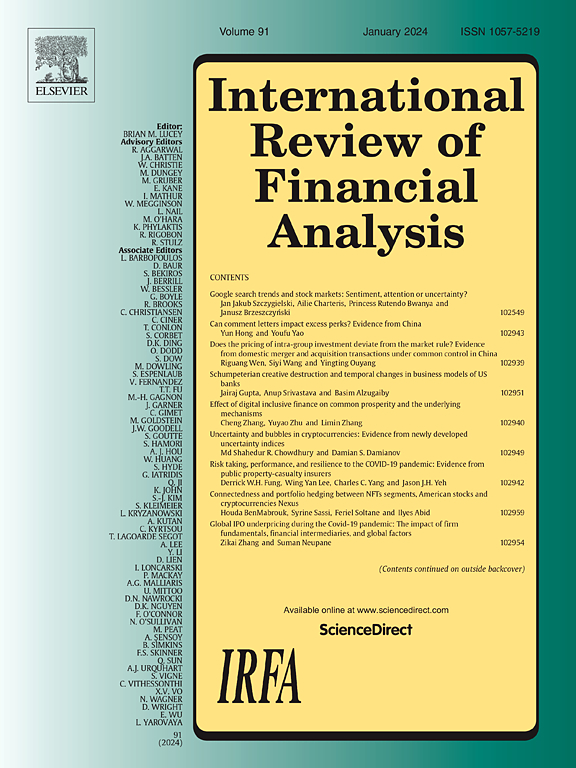绿色信贷政策与重污染企业的绿色转型
IF 7.5
1区 经济学
Q1 BUSINESS, FINANCE
引用次数: 0
摘要
本研究实证考察了绿色信贷政策对重污染企业绿色转型的影响。我们将绿色信贷指引的实施作为准自然实验,从生产和排放的角度分析其影响。结果表明,绿色信贷政策显著促进了重污染企业以预防为主导的绿色转型,同时抑制了以治理为主导的绿色转型。政策效果分析证实,绿色信贷政策通过限制信贷规模、收紧信贷渠道约束、提高环境信息披露质量、降低信贷成本,促进重污染企业绿色转型。研究结果表明,政策强度应随着企业污染程度的增加而增加。政策对不同类型企业影响的异质性分析表明,绿色信贷政策以低税收贡献、高质量的内部控制和有利的金融地理定位显著地促进了重污染企业的绿色转型。进一步分析表明,国有和政治关系会阻碍绿色信贷政策的有效实施,而具有金融背景的高管可以增强其效果。本研究为绿色信贷政策如何促进重污染企业绿色转型提供了实证证据,并强调了政策需要注重识别企业内外部资源的特征。加强绿色信贷政策的环境信息披露和监管机制,优化与企业特点相关的识别和反馈机制,确保政策的公平性和有效性。本文章由计算机程序翻译,如有差异,请以英文原文为准。
Green credit policy and heavily polluting enterprises' green transition
This study empirically examines how green credit policy affects the green transition of heavily polluting enterprises. We use the implementation of the Green Credit Guidelines as a quasi-natural experiment to analyze the effects from production and emissions perspectives. The results reveal that green credit policy significantly promotes a prevention-led green transition while inhibiting a governance-led green transition in heavily polluting enterprises. The policy effects analysis confirms that green credit policy promotes heavily polluting enterprises' green transition by restricting credit scale, tightening credit channel constraints, improving environmental information disclosure quality, and lowering credit costs. The findings suggest that policy intensity should increase with enterprises' pollution level. Heterogeneity analysis of policy effects on different types of enterprises reveals that green credit policy significantly aids heavily polluting enterprises' green transition with low tax contributions, high-quality internal controls, and favorable financial geographic positioning. Extended analysis reveals that state ownership and political connections can hinder effective green credit policy implementation, while executives with financial backgrounds can enhance its effects. This study provides empirical evidence on how green credit policy promotes heavily polluting enterprises' green transition and highlights the need for policy to focus on identifying the characteristics of enterprises' internal and external resources. Strengthening green credit policy's environmental information disclosure and regulatory mechanisms and optimizing the identification and feedback mechanisms related to enterprise characteristics will ensure the policy's fairness and effectiveness.
求助全文
通过发布文献求助,成功后即可免费获取论文全文。
去求助
来源期刊

International Review of Financial Analysis
BUSINESS, FINANCE-
CiteScore
10.30
自引率
9.80%
发文量
366
期刊介绍:
The International Review of Financial Analysis (IRFA) is an impartial refereed journal designed to serve as a platform for high-quality financial research. It welcomes a diverse range of financial research topics and maintains an unbiased selection process. While not limited to U.S.-centric subjects, IRFA, as its title suggests, is open to valuable research contributions from around the world.
 求助内容:
求助内容: 应助结果提醒方式:
应助结果提醒方式:


